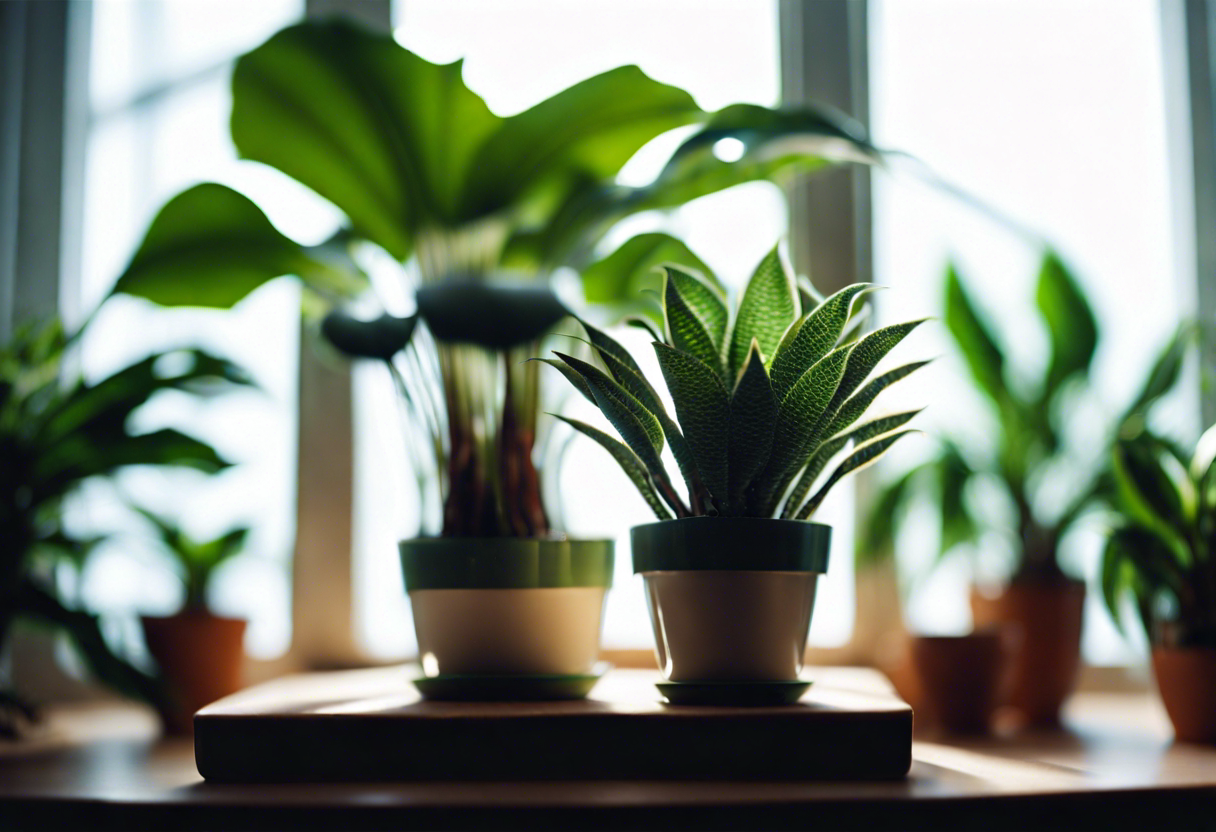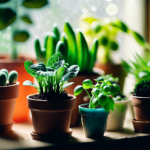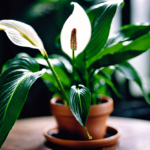Benefits of Having Pet-Friendly Indoor Plants
If you’re a pet owner and also enjoy having indoor plants, you’ll be pleased to know that there are plenty of pet-friendly options available. these plants into your home can offer numerous benefits for both you and your furry friends. Not only do they enhance the aesthetic appeal of your living space, but they can also improve air quality and provide a sense of tranquility. In this article, we will explore the many advantages of having pet-friendly indoor plants.
One of the key benefits of having pet-friendly indoor plants is their ability to purify the air. Plants naturally absorb carbon dioxide and release oxygen through a process called photosynthesis. By doing so, they can help filter out pollutants and improve indoor air quality. This is especially beneficial for pets, as they are prone to respiratory issues and can be sensitive to airborne allergens.
Additionally, having indoor plants can create a more relaxing and calming environment for both pets and humans alike. The presence of greenery has been shown to reduce stress levels and promote a sense of well-being. This can be particularly beneficial for pets, especially those who may experience anxiety or separation issues when left alone at home. Surrounding them with pet-friendly plants can create a soothing atmosphere and help keep them calm and content.
Another advantage of pet-friendly indoor plants is their aesthetic appeal. They can add a touch of nature to your living space, making it feel more vibrant and inviting. Whether you choose small potted plants or larger statement pieces, the beauty of indoor plants can enhance the overall ambiance of your home. Not only will you enjoy their visual appeal, but your pets will also appreciate the natural elements they bring into their environment.
When incorporating pet-friendly indoor plants into your home, it’s important to consider their safety. Some common houseplants can be toxic to pets if ingested. However, with careful selection, you can create a green space that is safe and enjoyable for both you and your furry friends. Look for pet-friendly plants such as spider plants, Boston ferns, and areca palms, which are non-toxic and pose minimal risks to pets.
There are numerous benefits to having pet-friendly indoor plants. They not only have the ability to purify the air and create a calming atmosphere, but they also add beauty and aesthetic appeal to your living space. By carefully choosing non-toxic plants, you can ensure the safety of your pets while enjoying all the advantages these green companions have to offer. So go ahead, bring some green into your home and create a pet-friendly sanctuary for both you and your beloved pets.
Popular Indoor Plants That Are Safe for Pets
Introduction
When it comes to creating a pet-friendly environment in your home, choosing the right indoor plants is essential. Not only do indoor plants add beauty and freshness to your living space, but they can also have several health benefits for both you and your furry friends. However, it’s important to keep in mind that not all indoor plants are pet-friendly. Some plants can be toxic to animals if ingested. In this article, we will explore some popular indoor plants that are safe for pets, allowing you to bring the beauty of nature into your home without worrying about your pet’s well-being.
Spider Plant (Chlorophytum comosum)
Spider plants are not only visually appealing with their long, arching leaves, but they are also safe for pets. These plants are non-toxic to cats and dogs, making them an excellent choice for households with furry friends. Spider plants are relatively easy to care for and can thrive in a variety of lighting conditions, making them suitable for different areas of your home.
Boston Fern (Nephrolepis exaltata)
If you’re looking for a pet-friendly indoor plant that adds a touch of elegance to your space, the Boston fern is an excellent choice. This plant features lush, feathery fronds and is known for its air-purifying properties. Boston ferns are safe for pets and make a beautiful addition to any room. Keep in mind that these plants require high humidity levels, so misting the leaves regularly can help keep them healthy.
Areca Palm (Dypsis lutescens)
The Areca palm, also known as the butterfly palm, is a popular choice for pet owners. This tropical plant features delicate, feathery fronds and can add a touch of paradise to your indoor space. The Areca palm is non-toxic to dogs and cats, making it a safe option for pet owners. This plant thrives in bright, indirect light and requires regular watering to keep the soil moist.
Money Tree (Pachira aquatica)
The Money Tree is not only believed to bring good luck and prosperity, but it is also safe for pets. This plant features a unique braided trunk and glossy, palmate leaves. The Money Tree prefers bright, indirect light and moderate watering. It is important to note that while the Money Tree is safe for pets, some pets may experience digestive issues if they consume large quantities of the plant’s leaves.
Choosing indoor plants that are safe for pets is crucial for creating a pet-friendly environment in your home. Plants such as the Spider Plant, Boston Fern, Areca Palm, and Money Tree not only add beauty to your space but also pose no harm to your furry friends. Remember to always research and verify the pet-friendliness of any plant before bringing it into your home. By incorporating these pet-friendly indoor plants, you can create a harmonious and safe living space for both you and your pets.
Choosing Pet-Friendly Indoor Plants: A Guide to Ensuring Your Pet’s Safety
When it comes to indoor plants, pet owners need to be cautious and selective. While plants can add beauty and freshness to your home, some varieties can be toxic to pets if ingested. It’s important to choose pet-friendly indoor plants to ensure your furry friends stay safe and healthy. Here are some tips to help you choose the right indoor plants for your pet’s safety.
First and foremost, research is key. Before bringing any new plant into your home, educate yourself about its potential toxicity to pets. Certain plants, such as lilies, pothos, and aloe vera, can be harmful or even deadly to cats and dogs. Others, like spider plants, Boston ferns, and bamboo palm, are considered safe and non-toxic. Take the time to familiarize yourself with which plants to avoid and which are pet-friendly.
Consider the habits and behavior of your pets. Some pets, especially cats, have a tendency to chew on leaves or dig in the soil. If you have a curious pet that loves to explore plants, it’s best to choose varieties that are non-toxic and won’t harm them if ingested. Opt for plants with sturdy foliage and avoid those with sharp thorns or prickly leaves that could potentially injure your pets.
Be mindful of the location where you place your indoor plants. Make sure they are out of reach or safely secured in areas that are inaccessible to your pets. Consider using hanging planters or placing plants on high shelves or countertops to prevent accidental ingestion. Additionally, avoid placing plants near their food or water bowls, as this may entice them to investigate or nibble on the foliage.
Regularly inspect your indoor plants for any signs of damage or wilting. It’s essential to maintain healthy plants to reduce the risk of your pets coming into contact with potentially harmful substances. Remove any fallen leaves or flowers promptly, as these can be enticing to pets and may pose a choking hazard. Keep the soil of your plants moist but not overly wet to prevent fungal growth and attract pests.
If you have any doubts about a specific plant’s safety or if you suspect your pet has ingested a toxic plant, contact your veterinarian immediately. Some common signs of plant poisoning in pets include vomiting, diarrhea, excessive drooling, lethargy, and loss of appetite. Acting quickly will ensure that your pet receives the proper care and treatment they need.
Selecting pet-friendly indoor plants is crucial for the well-being of your beloved pets. By researching plant toxicity, considering your pet’s behavior, and placing plants strategically, you can create a safe environment for both your pets and plants to thrive in harmony. Remember to monitor your plants regularly and seek professional help if you suspect your pet has ingested something harmful. With careful consideration and precautionary measures, you can enjoy the beauty of indoor plants while keeping your furry friends safe.
Placement and Care Tips for Pet-Friendly Indoor Plants
Caring for indoor plants not only adds beauty to your home but also provides numerous benefits for you and your pets. However, it is crucial to consider the safety of your furry friends when choosing and placing indoor plants. By following some simple tips, you can ensure that your pets remain safe while enjoying the benefits of these natural additions to your home.
1. Do Your Research
Before bringing any plants into your home, it is essential to research their toxicity levels to pets. Some common houseplants, such as lilies, ivy, or certain species of ferns, can be toxic to cats or dogs if ingested. By familiarizing yourself with which plants are safe and which are not, you can make an informed decision when choosing indoor plants.
2. Elevated Placement
One effective way to keep your pets away from your indoor plants is by placing them in elevated locations. Hanging planters or shelves can be great options, as they provide a barrier between your pets and the plants. Ensure that the shelves or hangers are securely installed to prevent any accidents.
3. Create Barriers
If you prefer to place your indoor plants on the ground or lower surfaces, consider creating physical barriers to discourage your pets from accessing them. For example, you can use fences or decorative screens to block off the area around the plants. This will prevent your furry friends from mistakenly nibbling on leaves or digging up soil.
4. Use Pet-Friendly Potting Soil
When potting your indoor plants, opt for pet-friendly potting soil. Regular potting soil often contains additives such as fertilizer or chemicals that can be harmful to pets if ingested. Pet-friendly potting soil is formulated to be safe for animals, ensuring that even if your pets accidentally consume some soil, they won’t be at risk.
5. Be Mindful of Watering
Proper watering is crucial for the health of your indoor plants, but it’s essential to be mindful of where the excess water goes. Avoid letting water accumulate near your plants, as it may attract your pets and potentially cause them harm. Ensure that the water drains properly or use saucers to catch excess water and empty them promptly.
6. Regularly Inspect Plants
Regularly inspect your indoor plants for any signs of damage or wilting. If you notice any decaying leaves or other issues, remove them promptly to prevent your pets from being exposed to potentially toxic substances. Additionally, keep an eye out for any fallen plant parts or debris that may be tempting for your pets to investigate.
By following these placement and care tips, you can create a pet-friendly environment with indoor plants while keeping your beloved animals safe. these measures will not only ensure your pets’ well-being but also allow you to enjoy the beauty and benefits of having greenery inside your home. Remember, the safety and happiness of your pets should always be a top priority when introducing new elements into their shared living space.
Common Toxic Indoor Plants to Avoid when You Have Pets
Overview
When you have pets, it’s essential to create a safe environment for them within your home. While indoor plants can enhance the aesthetic appeal of your space, some of them can pose a threat to your furry friends. Certain plants contain toxins that, if ingested by pets, can lead to various health issues. To ensure the well-being of your pets, it’s important to be aware of the common toxic indoor plants and avoid incorporating them into your home decor.
Toxic Indoor Plants to Avoid
-
Lilies: While lilies are known for their stunning flowers, they are highly toxic to cats. All parts of the plant, including the leaves, flowers, and even the pollen, can be harmful if ingested. Ingestion can lead to kidney failure, vomiting, and even death in severe cases. It’s crucial to keep lilies completely out of reach of your feline friends.
-
Sago Palm: The Sago Palm is a popular ornamental plant; however, it is highly toxic to both cats and dogs. All parts of this plant contain a toxin called cycasin, which can severely damage the liver and cause symptoms such as vomiting, diarrhea, and even liver failure. It’s best to avoid having the Sago Palm in your home if you have pets.
-
Dieffenbachia: Also known as Dumb Cane, Dieffenbachia is a tropical plant with large, lush leaves. While it is a beautiful addition to any indoor space, it can cause oral irritation, swelling, and difficulty swallowing if chewed or ingested by your pets. Keep this plant out of reach to prevent any accidental nibbling.
-
Aloe Vera: Aloe Vera has numerous benefits for humans, but it is toxic to both cats and dogs. The gel found inside the plant’s leaves can cause vomiting, diarrhea, and tremors if ingested by pets. Ensure that any Aloe Vera plants are kept well away from your furry friends.
-
Pothos: Pothos, also known as Devil’s Ivy, is a popular trailing plant known for its heart-shaped leaves. While it is aesthetically pleasing, it can cause oral irritation, vomiting, and difficulty swallowing if consumed by pets. Keep this plant out of reach or consider using a hanging planter to prevent access.
When you have pets, it’s crucial to be cautious about the plants you bring into your home. By avoiding common toxic indoor plants like lilies, Sago Palms, Dieffenbachia, Aloe Vera, and Pothos, you can ensure the safety and well-being of your furry friends. Remember to research any plant before bringing it home and consult your veterinarian if you suspect your pet has ingested a toxic plant. By creating a pet-friendly environment, you can enjoy the beauty of indoor plants without compromising on the health and safety of your beloved pets.
Conclusion
Incorporating pet-friendly indoor plants into your home not only adds a touch of natural beauty but also brings numerous benefits for both you and your furry friends. These plants not only improve air quality by filtering toxins, but they can also enhance your pet’s overall well-being.
There are several popular indoor plants that are safe for pets, such as the spider plant, Boston fern, and Areca palm. These plants are non-toxic and pose no harm to your curious pets even if they accidentally nibble on a leaf or two. By choosing these pet-friendly plants, you can create a harmonious environment where your pets can roam freely without worry.
When selecting indoor plants for pet safety, it is crucial to consider factors such as toxicity levels, plant habits, and your pet’s behavior. Opting for plants with nontoxic leaves and avoiding those with spiky thorns or hanging vines can help prevent any accidents or ingestions. Researching the specific needs and behaviors of your pet will also enable you to choose the most suitable plants that align with their preferences and natural behaviors.
To ensure the well-being of both your pets and your plants, proper placement and care are essential. Place your pet-friendly plants in areas that are out of reach, such as on high shelves or hanging planters. This prevents pets from accidentally knocking them over or accessing them easily. Providing sufficient light, water, and proper drainage for your plants will help them thrive while also ensuring that your pets’ curiosity doesn’t get the best of them.
While it’s crucial to focus on pet-friendly indoor plants, it’s equally important to be aware of the potential dangers that certain plants can pose to your pets. Common toxic indoor plants to avoid when you have pets include lilies, aloe vera, and pothos. These plants can cause various health issues, ranging from mild gastrointestinal upset to more severe complications. Familiarize yourself with the toxic plants and keep them out of your home to prevent any unfortunate incidents.
Incorporating pet-friendly indoor plants into your home provides numerous benefits for both you and your beloved pets. By choosing non-toxic plants, considering your pet’s habits, and providing proper care and placement, you can create a safe and healthy environment for everyone. Remember to avoid toxic indoor plants and always prioritize your pet’s well-being when selecting plants for your home. With the right balance of greenery and pet-friendly practices, you can enjoy the beauty and serenity of indoor gardening while ensuring the safety of your furry companions.


